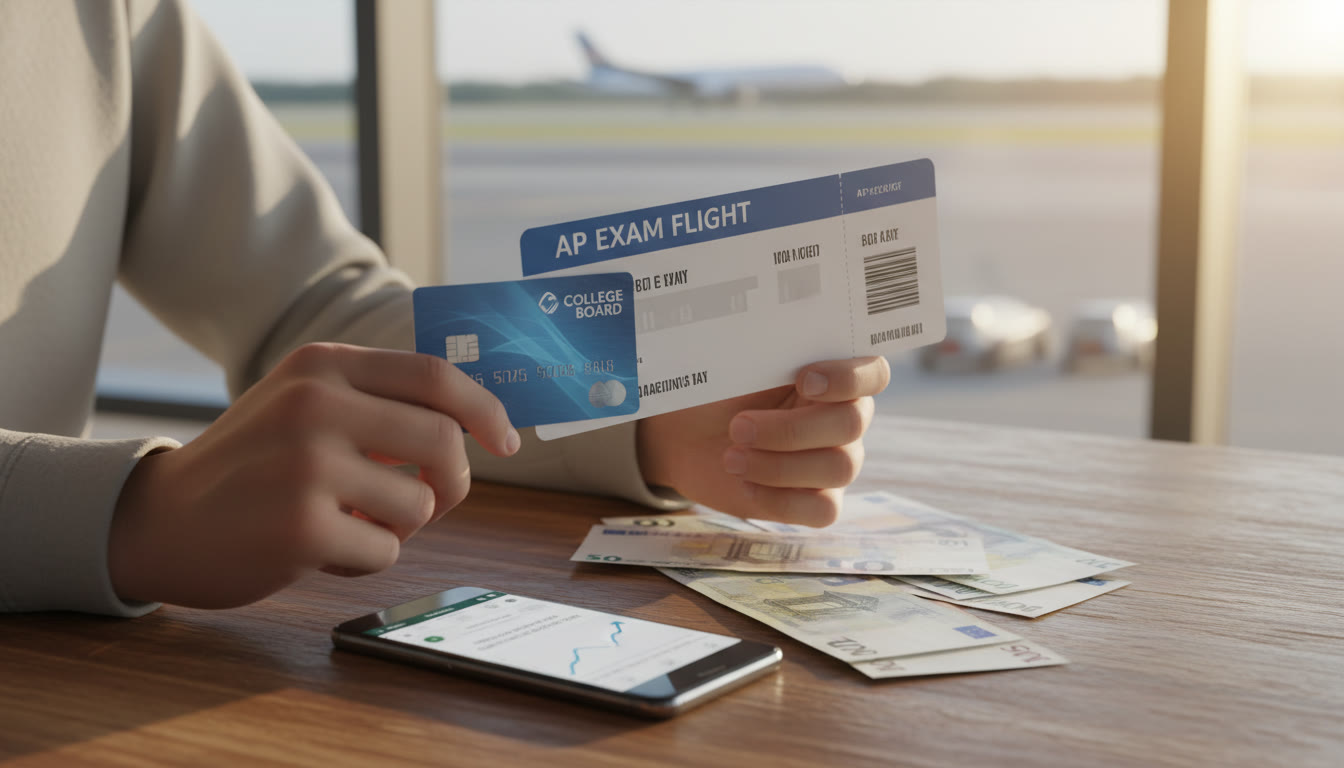Why Parents Need to Know About International Payments and Currency Gotchas
When your teen signs up for an AP exam abroad, plans a study trip, or pays for a remote tutor overseas, money starts doing unexpected things. We imagine a simple card swipe and done — but behind that swipe are exchange rates that move, fees that hide in fine print, and transfer routes that take time. As a parent, you don’t need to become a currency trader, but a little practical knowledge will save time, money, and a lot of last-minute stress.
This guide is written for busy parents who want clear, human-centered explanations and actionable steps. We’ll walk through common scenarios families face, explain the typical pitfalls (or “gotchas”), offer concrete examples, and give a checklist you can keep in your wallet — or save on your phone. Along the way I’ll show how conversational support and personalized tutoring — for example, Sparkl’s 1-on-1 guidance and tailored study plans — can help teens build the real-world skills they need when studying or traveling internationally.
Common Scenarios Where Currency and Payments Matter
1. Paying for AP-related fees, tutors, or materials from another country
Whether it’s an online tutor based abroad, specialty AP prep materials from an international publisher, or exam registration through a school in another country, your payment might cross borders. That triggers currency conversion, potential foreign transaction fees, and sometimes delays.
2. Student travel and study abroad during AP summers
Summer study programs, exchange trips, or university visits are exciting — and expensive. Local ATM withdrawals, cash purchases, and prepaid program fees each have their own conversion quirks.
3. Receiving refunds or scholarships from overseas
Getting money back or receiving a small scholarship from abroad can be trickier than sending it. Refunds may arrive in foreign currency, be routed through intermediate banks, or arrive with fees deducted.
Key Currency Concepts, Plain and Simple
Exchange Rate
This is the price of one currency in terms of another. If 1 USD = 0.90 EUR, one US dollar will buy 0.90 euros. Rates fluctuate constantly based on markets — so the exact amount you pay or receive can change day to day.
Spread (or Markup)
Retail banks and payment platforms typically add a markup on top of the mid-market exchange rate (the one you see on finance pages). That markup — called the spread — is how they make money on conversions. Even if a service advertises “no fee,” it may still include a spread.
Foreign Transaction Fee
A percentage added when you use your credit or debit card abroad, often 1%–3% of the amount. Some cards waive this fee — a small detail that can add up over a summer of travel.
Intermediary Bank Fees
When wiring money internationally, your payment might route through intermediate (correspondent) banks that charge fees. Those fees can be fixed amounts or percentages deducted from the transfer.
Most Common Gotchas and How to Avoid Them
Gotcha 1: Thinking the posted exchange rate is the one you’ll get
What you see online is often the mid-market rate. The rate you get on a card transaction or bank transfer will likely be worse because of spreads. Practical fix: compare the total cost (including visible fees and estimated spread), not just the exchange rate.
Gotcha 2: Ignoring foreign transaction and ATM fees
Using an ATM abroad can cost you both a local ATM fee and a fee charged by your home bank. Keep a backup plan: carry a small amount of local currency, and get a card that waives foreign transaction fees for travel.
Gotcha 3: Surprised by bank transfer processing time
International wires may take 1–5 business days — sometimes longer if routed through several banks or if documentation is missing. If you’re registering for an AP exam or paying program fees, allow extra time or use a same-day online transfer service where possible.
Gotcha 4: Receiving refunds in local currency — and losing on conversion
If a program refunds you in their local currency, your bank may convert it back at an unfavorable rate, and sometimes deduct fees. If the refund is significant, ask if they can refund to the original card or in your preferred currency.
Gotcha 5: Dynamic currency conversion (DCC) lure
In some countries, merchants offer to charge you in your home currency at the point of sale using Dynamic Currency Conversion. The rate is often unfavorable. Ask to be charged in the local currency instead and let your own card issuer handle the conversion.
Quick Practical Examples
Examples make these ideas less abstract. Here are three everyday situations with numbers you can easily follow.
Example A: Paying an overseas tutor
Scenario: A monthly fee of 100 EUR for online AP tutoring.
| Item | Option 1: Pay by bank wire | Option 2: Pay by card via a payments platform |
|---|---|---|
| Posted mid-market rate | 1 USD = 0.90 EUR | 1 USD = 0.90 EUR |
| Bank spread / markup | 2% (bank) → effective rate 1 USD = 0.882 EUR | 3% (platform) → effective rate 1 USD = 0.873 EUR |
| Foreign transaction fees | Possible fixed fee of $15 + 0.5% intermediary | Often included in platform markup |
| Approx USD you’ll pay | ~$113 (100 EUR ÷ 0.882) | ~$114.5 (100 EUR ÷ 0.873) |
Lesson: Even small markups add up across months — consider payment platforms that show transparent conversion or negotiate a billing in USD.
Example B: ATM withdrawals on a study trip
Scenario: Your teen withdraws €200 in France using a U.S. debit card.
- Bank A charges a 3% foreign transaction fee + $5 ATM fee.
- Bank B charges no foreign transaction fee but the ATM operator charges €3 plus a local surcharge.
Result: Bank B may be cheaper even with ATM fees because there’s no percentage fee on the amount. Tip: Withdraw larger amounts less frequently to reduce fixed fees, but weigh safety concerns and local cash needs.
Example C: Refunding program fees
Scenario: A summer program in the UK refunds £500, but the program sends the refund in GBP.
- If your bank converts at a poor rate and charges a fee, you might lose 2%–4% during conversion.
- If the refund is processed to the original card, you may get an easier reversal at the exact original exchange rate (or close to it).
Lesson: Ask the organization to refund to the same payment method and in the same currency if possible.
Checklist: What to Do Before Your Teen Goes Abroad or Pays Internationally
Here’s a compact checklist you can run through a week or two before travel or an international payment:
- Check card foreign transaction fees and ATM fees. Consider a travel-friendly card that waives these fees.
- Carry a small amount of local currency for immediate needs on arrival.
- Inform your bank of travel dates and destinations to avoid fraud blocks.
- Confirm payment deadlines and allow several business days for international transfers.
- Request refunds to the original payment method and currency when possible.
- Compare total cost (including spread), not just advertised rates.
- Keep receipts and screenshots of payments until transactions settle.
How to Choose the Right Payment Method
Debit or Credit Card?
Credit cards with no foreign transaction fees are often the best for purchases: they offer fraud protection and sometimes travel benefits. Debit cards are handy for ATM withdrawals but may offer less dispute protection.
Bank Wire vs. Online Money Transfer Service
For one-off large payments (tuition or program fees), compare a bank wire to reputable online transfer services. Bank wires are reliable but can be expensive (fixed fees + spread). Online services often show a clearer, lower-cost exchange with smaller transparent fees — but check transfer speed and reviews.
When to Use Cash
Cash is essential in some places and for tipping. Withdraw larger sums less frequently to reduce fixed ATM fees, and avoid carrying large amounts of cash in unsafe situations.
Teaching Teens to Think About Money Abroad
Helping teens develop healthy money habits is as important as helping them study. Here are conversation starters and small habits you can teach:
- Show them how to check an online exchange rate and then compare it to what their card shows on a statement.
- Ask them to keep a simple travel spending log on their phone: date, merchant, local amount, and the USD charge when it posts.
- Teach them to decline Dynamic Currency Conversion and instead have transactions processed in the local currency.
- Practice deciding when to use cash versus card: think safety, fees, and convenience.
When to Get Professional Help
There are moments when a conversation with a specialist saves far more than an hour of your time. High-value international transactions (like tuition, program deposits, or large refunds) often benefit from professional guidance.
Sparkl’s personalized tutoring goes beyond AP content; for families managing study-abroad logistics or overseas program payments, Sparkl’s 1-on-1 guidance and expert tutors can help teens build planning skills — from budgeting a summer program to understanding how international billing works. Tutors who know these realities can weave practical money sense into academic preparation, helping teens feel confident and independent.
Smart Habits for Parents Managing Payments
- Keep a dedicated folder (physical or digital) for international receipts, confirmations, and communications.
- Use two-step verification for payment platforms and bank accounts to reduce fraud risk.
- Set calendar reminders for automatic payments and deadlines — and give an extra buffer for international processing.
- Consider short-term travel cards or prepaid travel cards if you prefer to limit direct account exposure.
Sample Conversation: Preparing for a Summer AP Program Abroad
Use this script to guide a calm, practical family conversation:
- Parent: “The program fee is due in pounds. Do they let us pay by card in USD?”
- Program admin (hypothetical): “We can bill your card in USD, but we recommend charging in GBP because of lower local processing fees.”
- Parent: “If they bill in GBP, what rate and fees will my bank apply?”
- Teen: “I’ll ask the bank and compare with a transfer service. Also, Sparkl suggested I prepare a budget for the trip so I know how much cash to bring.”
Outcome: You collect the information, compare the cost of billing options, and pick the one with the lowest total cost and least hassle.
Table: Quick Comparison Guide — Which Option to Use
| Scenario | Best Option | Why |
|---|---|---|
| Paying small recurring tutoring fees | Card via transparent payments platform | Convenience, speed, dispute protection |
| Paying large one-time program tuition | Bank transfer or trusted online transfer service | Lower total cost for large sums if you compare spreads and fees |
| ATM cash while traveling | Withdraw larger amounts less often with an ATM-fee-free card | Reduces fixed ATM fees; carry a safety amount |
| Refunds from overseas organizers | Ask for refund to original card in original currency | Avoids a second conversion and reduces losses |
Real-World Parent Stories (Short)
1) A parent who paid an AP prep program deposit by international wire discovered two intermediary fees took 20% of the refund when the program canceled. Lesson: always ask who pays intermediary fees and whether billing in USD is possible.
2) A teen used a credit card that waived foreign transaction fees and ended up saving over $150 during a month-long language program compared with a friend who used a bank that charged 3% per purchase. Lesson: a travel-friendly card pays for itself quickly.
Final Tips — A Parent’s Cheat Sheet
- Compare total cost, not just the listed exchange rate.
- Avoid Dynamic Currency Conversion at the point of sale — opt for the local currency.
- Notify banks before travel to avoid fraud holds.
- Use payment methods with strong fraud protection for big payments.
- Keep emergency contact numbers for your bank and card providers handy.
- Teach your teen to track spending so refunds and statements are easy to reconcile.

Bringing It Back to AP and Academic Planning
Money and logistics are part of the larger project of supporting your teen’s academic journey. Test prep, AP exams, summer programs, and study-abroad experiences all intersect with real-world financial decisions. When a student understands how payments work, they’re less stressed and more focused on learning.
Integrating money-savvy habits into AP preparation gives teens an edge beyond scores. Sparkl’s personalized tutoring and tailored study plans can fold practical life skills into academic tutoring: helping a teen plan a budget for an AP summer course, schedule milestones for exam registration payments, or practice professional communication with program coordinators. Tutors often share small, immediately useful tips — like comparing total payment costs or how to avoid costly ATM withdrawals — which add up to big savings and smoother experiences.
Parting Thought
International payments and currency aren’t glamorous topics, but they’re squarely practical and enormously useful. A little preparation goes a long way: know the fees, ask the right questions, compare total costs, and teach your teen those same habits. That combination protects your wallet and gives your child confidence that they can handle both the academic and logistical challenges of studying in a connected world.

Need More Help?
If you want tailored guidance that connects academic prep with real-life logistics, consider a conversation with a tutor who understands both AP goals and the practicalities of study travel. That kind of 1-on-1 mentoring — balancing exam strategy and life skills — helps teens arrive prepared, confident, and ready to learn.
Remember: a smart payment strategy is just another form of preparation. With a little planning, your family can focus on what matters most — your teen’s growth and the experiences that expand their world.





















No Comments
Leave a comment Cancel